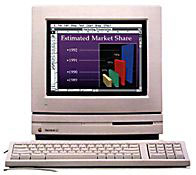It started life as a 'multimedia powerhouse.' Purchased in the
summer of 1993 along with an external NEC SCSI Multispin CD-ROM drive,
this little LC III was placed
prominently in a middle school library. It was mainly dedicated to
running Grolier's Multimedia Encyclopedia and a few other multimedia
titles. It also was loaded with the library's card catalog and several
student-made Hyperstudio stacks full of information gathered from field
trips and other projects.

Macintosh LC III
This wonderful pizza box shaped machine served this purpose nicely
for two years, until a newer, faster, all-in-one 5200 replaced it and sent the
LC III to the corner for word processing. Gradually it was getting less
and less use and was starting to gather a little dust.
Jump ahead to the fall of 1996. The school district I was working
for was getting its first dedicated Internet service. I needed to put
up a mail server quickly and inexpensively. I didn't have the time to
teach myself Unix, and I really did not want to purchase another
Windows machine and software, though it looked like that was what I
would have to do.
A few phone calls gave me a recommendation for the free Apple
Internet Mail Server. I grabbed the lonely little LC III, not sure it
had enough beef to run email for 100+ clients, but I thought it was
worth a try. Within two hours I had the machine loaded with the AIMS
software and fired it up. It did not take long before it was moving
thousands of email messages every day, and it was up to the task. I
attached an external SCSI drive that I used for periodic backups, and
the machine required almost no maintenance, just faithfully doing its
job without missing a beat.
I did tweak the machine a little bit, installing a minimal
configuration of System 7.6.1 and an upgrade to a 1 GB internal
drive with 16 MB of RAM. There were very few other changes made or
necessary. Apple Internet Mail Server later became Eudora
Internet Mail Server, so I did make that change.
This machine did the trick for over three years until spam began to
be more of an issue. There was little protection from relaying in the
program, so an upgrade to a more powerful program and more powerful
machine became necessary. The LC III barely made it to the new
millennium, being retired early in 2000.
In 2001 I took a job with a private company providing sales,
training, and technical support for school districts. When I went back
to visit my old district, there were several old machines being
earmarked for disposal. I bought a few of the machines and walked away
with the LC III for free, not sure what I would do with it, if
anything.
In 2003, I was helping a very small rural school district get their
network set up. Their Internet provider promised email service as part
of their package, but said it would be at least six months before they
could get it set up. I grabbed the LC III and set it up, providing a
very nice temporary solution. Later, the Exchange Server in our office
went down and the LC III filled the bill for about two weeks. 10 years
after its original purchase, this machine was still being useful.
Missing the school setting, I quit the private business and took an
elementary teaching job. Almost as an afterthought, I picked up the LC
III as I was cleaning out my office, feeling pretty sure that it had
outlived its usefulness. My new school was not very high tech and was
officially all PC based. I did manage to scrape together a few older
iMacs for student use, but I needed a printer for them to print to. I
found an old Personal LaserWriter 4/600, but it was a LocalTalk only
printer, lacking an Ethernet port, and the iMacs had no LocalTalk
port.
The light bulb turned on, and the LC III was once again pulled out
of retirement. I knew of a free download from Apple of a control panel
called LocalTalk
Bridge, and I was able to connect the printer to the LC III and
share it across the network using the LC III as a print server. With a
wireless router, I was even able to set up wireless printing in my
classroom with almost no investment. The printer is slow but reliable,
and with the LC III churning away, it eventually printed everything we
sent to it.
I did manage to get a faster printer with a built-in Ethernet port,
so once again the LC III is sitting on a shelf. It had found use into
its fourteenth year, and I would not be surprised if it comes out of
retirement once again to fill a need. Though some Apple machines have
been more reliable than others, for the most part, Macs outlive their
usefulness long before they wear out.
But maybe they never really do outlive their usefulness. It's more a
matter of understanding what can be done with a low-end machine. I
don't know what use I may find for this 15-year-old computer, but
whatever it may be, I'm sure the LC III will be ready and willing.
Share your perspective on the Mac by emailing with "My Turn" as your subject.



